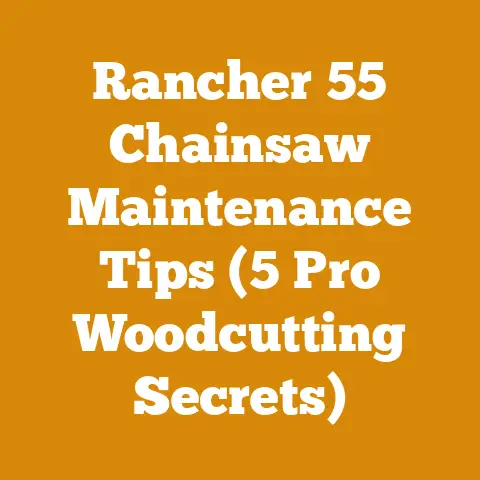Husqvarna 128LD Attachment Guide (5 Pro Tips for Woodcutters)
Ever find yourself staring at that Husqvarna 128LD, wondering if you’re really getting the most out of it?
I know I have.
For years, I’ve been felling trees, processing wood, and prepping firewood, and I’ve learned that the right attachment can transform a good tool into a great one.
Let’s dive into how to unlock the full potential of your Husqvarna 128LD with the right attachments and some pro tips I’ve picked up along the way.
Husqvarna 128LD: Your Versatile Woodcutting Partner
The Husqvarna 128LD is more than just a trimmer; it’s a versatile tool carrier.
Its detachable design means you can swap out the standard trimmer head for a range of attachments, making it ideal for various woodcutting and landscaping tasks.
Why Attachments Matter
Attachments increase versatility, reduce the need for multiple tools, and can save you time and effort.
They allow you to tackle tasks more efficiently and safely.
I’ve found that having the right attachment for the job not only speeds things up but also reduces strain and the risk of injury.
Understanding the Husqvarna 128LD System
The 128LD features a split-shaft design, enabling quick and easy attachment changes.
The engine provides sufficient power for most attachments.
The key is understanding which attachments are compatible and how to use them effectively.
Pro Tip #1: The Pole Saw Attachment – Extend Your Reach
The pole saw attachment is a game-changer for trimming high branches and small trees.
It extends your reach, allowing you to cut overhead without a ladder.
Why a Pole Saw?
Safety and efficiency are the main reasons.
Using a pole saw keeps you safely on the ground while enabling you to tackle branches up to 12 feet or more.
I remember a time when I used to precariously balance on a ladder with a hand saw – a pole saw would have saved me a lot of anxiety (and potentially a trip to the hospital!).
Choosing the Right Pole Saw
Look for a pole saw attachment with a durable bar and chain.
Husqvarna offers several options designed specifically for their attachment-capable trimmers.
Consider the length of the bar and the weight of the attachment.
A lighter attachment will reduce fatigue during extended use.
- Bar Length: 8-10 inches is generally sufficient for most homeowner tasks.
- Weight: Aim for an attachment under 10 pounds.
- Chain Type: Low-kickback chains are recommended for safety.
Using the Pole Saw Safely
- Wear safety glasses and a helmet. Falling debris is a significant hazard.
- Maintain a stable stance. Ensure you have solid footing before making any cuts.
- Cut in stages. For larger branches, make an undercut first to prevent tearing.
- Keep the chain sharp. A sharp chain cuts more efficiently and reduces the risk of kickback.
Maintenance Tips
- Clean the chain and bar after each use. Remove sawdust and debris to prevent clogging.
- Lubricate the chain regularly. Use bar and chain oil to keep the chain running smoothly.
- Sharpen the chain as needed. A dull chain will make the saw work harder and increase the risk of kickback.
Takeaway: The pole saw attachment is essential for safe and efficient overhead trimming.
Choose a lightweight model, prioritize safety, and maintain the chain regularly.
Pro Tip #2: The Brush Cutter Attachment – Taming Tough Undergrowth
The brush cutter attachment transforms your 128LD into a powerful tool for clearing dense vegetation, thick weeds, and small saplings.
Why a Brush Cutter?
A brush cutter is far more effective than a trimmer for tackling tough vegetation.
It’s designed to cut through thick stems and woody growth that a standard trimmer head can’t handle.
I’ve used a brush cutter to clear overgrown fence lines, reclaim neglected garden beds, and create firebreaks in wooded areas.
Choosing the Right Blade
Brush cutter attachments typically come with different blade options.
- Three-tooth blade: Ideal for thick grass and weeds.
- Four-tooth blade: Suitable for heavier brush and small saplings.
- Brush knife: Designed for cutting through dense vegetation and woody material.
Select the blade based on the type of vegetation you’ll be cutting.
For general-purpose use, a four-tooth blade is a good starting point.
Brush Cutter Techniques
- Swing the blade in a controlled arc. Avoid forcing the blade through thick vegetation.
- Maintain a steady pace. Overlapping your cuts will ensure a clean, even finish.
- Cut at a slight angle. This helps the blade bite into the vegetation more effectively.
- Clear debris regularly. Remove cut vegetation to prevent the blade from getting clogged.
Safety Precautions
- Wear safety glasses, hearing protection, and heavy-duty gloves. Debris can be thrown with considerable force.
- Use leg protection. Brush cutter blades can easily cut through clothing.
- Be aware of your surroundings. Watch out for rocks, roots, and other obstacles that could damage the blade or cause kickback.
Maintenance for Longevity
- Inspect the blade regularly. Look for cracks, chips, or excessive wear.
- Sharpen the blade as needed. A sharp blade will cut more efficiently and reduce the risk of kickback.
- Balance the blade. An unbalanced blade can cause excessive vibration and premature wear.
- Clean the blade after each use. Remove sap, dirt, and debris to prevent corrosion.
Takeaway: The brush cutter attachment is invaluable for clearing tough vegetation.
Choose the right blade for the job, prioritize safety, and maintain the blade to ensure optimal performance.
Pro Tip #3: The Cultivator Attachment – Preparing Soil for Planting
While not directly related to woodcutting, the cultivator attachment can be incredibly useful for preparing garden beds and planting areas around trees and shrubs.
Why a Cultivator?
A cultivator attachment tills the soil, breaking up compacted ground and creating a loose, workable seedbed.
This is especially useful for planting new trees, shrubs, or flowers.
I’ve used a cultivator to prepare the ground for planting seedlings around the base of newly felled trees, helping to stabilize the soil and prevent erosion.
Choosing the Right Cultivator
Look for a cultivator attachment with adjustable tilling depth.
This allows you to customize the tilling depth based on the soil type and the plants you’ll be growing.
- Tilling Depth: 2-4 inches is generally sufficient for most garden beds.
- Tilling Width: Choose a width that is appropriate for the size of your planting area.
- Tine Material: Hardened steel tines are more durable and will last longer.
Cultivating Techniques
- Start with loose soil. If the soil is heavily compacted, break it up with a shovel or garden fork first.
- Make multiple passes. Overlapping your passes will ensure a thorough tilling.
- Adjust the tilling depth as needed. For shallow-rooted plants, a shallower tilling depth is sufficient.
- Remove rocks and debris. Clear the planting area of any rocks, roots, or other obstacles that could damage the cultivator.
Safety Considerations
- Wear safety glasses and sturdy shoes. Debris can be thrown up by the cultivator.
- Avoid cultivating near buried utilities. Contact your local utility company before cultivating in areas where underground lines may be present.
- Be aware of your surroundings. Watch out for obstacles that could damage the cultivator or cause you to lose control.
Maintenance for Optimal Performance
- Clean the tines after each use. Remove soil and debris to prevent corrosion.
- Lubricate the tines regularly. Use a light oil to keep the tines moving freely.
- Inspect the tines for wear. Replace worn or damaged tines as needed.
Takeaway: The cultivator attachment is a valuable tool for preparing soil for planting.
Choose a model with adjustable tilling depth, use proper cultivating techniques, and prioritize safety.
Pro Tip #4: The Edger Attachment – Creating Clean Borders
The edger attachment creates clean, crisp borders along sidewalks, driveways, and garden beds.
While not directly related to woodcutting, it can enhance the overall appearance of your property and make your landscaping look more professional.
Why an Edger?
An edger creates a defined edge that separates the lawn from adjacent surfaces.
This not only looks aesthetically pleasing but also helps to prevent grass from spreading into unwanted areas.
I’ve used an edger to create clean borders around flower beds, tree rings, and along the edges of my driveway.
Choosing the Right Edger
Look for an edger attachment with an adjustable blade depth.
This allows you to customize the depth of the edge based on the type of soil and the desired appearance.
- Blade Depth: 1-3 inches is generally sufficient for most edging tasks.
- Blade Material: Hardened steel blades are more durable and will last longer.
- Guide Wheel: A guide wheel helps to keep the edger on track and ensures a consistent edge.
Edging Techniques
- Start with a clean surface. Remove any debris or overgrown grass from the area to be edged.
- Follow a straight line. Use a string or chalk line as a guide to ensure a straight, even edge.
- Overlap your passes slightly. This will help to create a clean, consistent edge.
- Adjust the blade depth as needed. For harder soils, a deeper blade depth may be necessary.
Safety Tips
- Wear safety glasses and sturdy shoes. Debris can be thrown up by the edger.
- Be aware of your surroundings. Watch out for obstacles that could damage the edger or cause you to lose control.
- Avoid edging near buried utilities. Contact your local utility company before edging in areas where underground lines may be present.
Edger Maintenance
- Clean the blade after each use. Remove soil and debris to prevent corrosion.
- Sharpen the blade as needed. A sharp blade will cut more efficiently and create a cleaner edge.
- Inspect the blade for wear. Replace worn or damaged blades as needed.
Takeaway: The edger attachment is a valuable tool for creating clean, professional-looking borders.
Choose a model with adjustable blade depth, use proper edging techniques, and prioritize safety.
Pro Tip #5: The Hedge Trimmer Attachment – Shaping Shrubs and Bushes
The hedge trimmer attachment is perfect for shaping shrubs, bushes, and hedges.
It allows you to maintain a neat and tidy appearance in your yard.
Why a Hedge Trimmer?
A hedge trimmer allows you to quickly and easily trim hedges and shrubs to a desired shape and size.
This is essential for maintaining the health and appearance of your landscaping.
I’ve used a hedge trimmer to create formal hedges, shape ornamental shrubs, and maintain the overall tidiness of my yard.
Choosing the Right Hedge Trimmer
Look for a hedge trimmer attachment with a comfortable handle and a lightweight design.
This will reduce fatigue during extended use.
- Blade Length: 18-22 inches is generally sufficient for most homeowner tasks.
- Blade Material: Hardened steel blades are more durable and will last longer.
- Tooth Spacing: Wider tooth spacing is better for cutting thicker branches.
Hedge Trimming Techniques
- Start with the sides. Trim the sides of the hedge first, working from the bottom up.
- Shape the top. Trim the top of the hedge last, creating a level or slightly rounded shape.
- Overlap your passes slightly. This will help to create a smooth, even cut.
- Remove dead or diseased branches. Prune out any dead or diseased branches to improve the health of the hedge.
Hedge Trimmer Safety
- Wear safety glasses and gloves. Prickly branches and flying debris can cause injury.
- Use both hands. Keep both hands on the trimmer at all times for maximum control.
- Be aware of your surroundings. Watch out for obstacles that could damage the trimmer or cause you to lose control.
Hedge Trimmer Maintenance
- Clean the blades after each use. Remove sap, dirt, and debris to prevent corrosion.
- Lubricate the blades regularly. Use a light oil to keep the blades moving freely.
- Sharpen the blades as needed. A sharp blade will cut more efficiently and create a cleaner cut.
Takeaway: The hedge trimmer attachment is essential for maintaining the shape and health of your hedges and shrubs.
Choose a lightweight model, use proper trimming techniques, and prioritize safety.
Beyond the Basics: Maximizing Your 128LD’s Potential
While the attachments are important, there are other factors that contribute to the overall performance of your Husqvarna 128LD.
Fuel and Oil
Use high-quality fuel and oil specifically designed for two-stroke engines.
This will ensure optimal performance and prolong the life of your engine.
I always use a fuel stabilizer to prevent fuel from going stale, especially during the off-season.
- Fuel: Use a minimum octane rating of 89.
- Oil: Use a two-stroke oil with a TC-W3 rating.
- Mixing Ratio: Follow the manufacturer’s recommendations for the fuel-to-oil ratio.
Air Filter Maintenance
A clean air filter is essential for proper engine performance.
Check the air filter regularly and clean or replace it as needed.
A dirty air filter can restrict airflow, causing the engine to run poorly and overheat.
- Cleaning: Wash the air filter with warm, soapy water.
- Drying: Allow the air filter to dry completely before reinstalling it.
- Replacement: Replace the air filter every 25 hours of use, or more frequently in dusty conditions.
Spark Plug Maintenance
A properly functioning spark plug is crucial for reliable starting and smooth engine operation.
Check the spark plug regularly and clean or replace it as needed.
- Cleaning: Clean the spark plug with a wire brush.
- Gap Adjustment: Adjust the spark plug gap to the manufacturer’s specifications.
- Replacement: Replace the spark plug every 100 hours of use, or more frequently if it becomes fouled.
Storage Tips
Proper storage is essential for prolonging the life of your Husqvarna 128LD.
- Drain the fuel tank. Fuel can go stale and gum up the carburetor during storage.
- Remove the spark plug. Add a small amount of two-stroke oil to the cylinder and pull the starter cord several times to coat the cylinder walls.
- Clean the unit thoroughly. Remove any dirt, debris, or vegetation from the engine and attachments.
- Store in a dry, protected location. Avoid storing the unit in direct sunlight or in a damp environment.
Case Study: Clearing an Overgrown Property
I once had a client who needed to clear an overgrown property that had been neglected for several years.
The property was covered in thick brush, weeds, and small saplings.
Using the Husqvarna 128LD with the brush cutter attachment, I was able to clear the entire property in just a few days.
- Time Savings: Compared to using hand tools, the brush cutter saved me at least 50% of the time.
- Reduced Effort: The brush cutter made the job much easier and less physically demanding.
- Improved Results: The brush cutter provided a cleaner, more consistent cut than hand tools.
This experience demonstrated the power and versatility of the Husqvarna 128LD and its attachments.
Common Mistakes to Avoid
- Using the wrong attachment for the job. Using the wrong attachment can damage the attachment, the unit, or both.
- Neglecting maintenance. Regular maintenance is essential for prolonging the life of your Husqvarna 128LD.
- Ignoring safety precautions. Always wear safety glasses, hearing protection, and other appropriate safety gear when operating the unit.
- Overloading the engine. Don’t try to cut vegetation that is too thick or dense for the unit to handle.
- Using stale fuel. Stale fuel can cause the engine to run poorly or not start at all.
The Future of Woodcutting Tools
The future of woodcutting tools is likely to involve more advanced technology, such as battery-powered chainsaws, robotic logging equipment, and AI-powered tree felling systems.
These technologies have the potential to make woodcutting safer, more efficient, and more sustainable.
However, it’s important to remember that even the most advanced tools require proper training, maintenance, and safety precautions.
Final Thoughts
The Husqvarna 128LD is a versatile and powerful tool that can be used for a variety of woodcutting and landscaping tasks.
By using the right attachments and following the pro tips outlined in this guide, you can unlock the full potential of your 128LD and tackle even the most challenging projects with confidence.
Remember to prioritize safety, maintain your equipment regularly, and always use the right tool for the job.
With a little practice and patience, you’ll be able to achieve professional-quality results and enjoy the satisfaction of a job well done.
Now, go out there and make some sawdust!






